Assessment of Greywater Reuse in a University Building in a Hyper-Arid Region: Quantity, Quality, and Social Acceptance
Abstract
1. Introduction
2. Materials and Methods
2.1. Greywater Sample Collection
2.2. Greywater Sample Analysis
2.3. Student Questionnaire
2.4. Reuse Strategies
2.4.1. Toilet Flushing
2.4.2. Green Roof and Garden Watering
3. Results and Discussion
3.1. Greywater Quantity
- 1.
- Although the study buildings are of an educational type, it has been observed that the maturity of users leads to greater awareness of adequate water usage [37]. Therefore, older students tend to conserve more water by using less for handwashing;
- 2.
- 3.
- The methodology used to estimate greywater production varies from study to study. Research that relied on surveys to calculate greywater production might overestimate this quantity, mainly due to people’s lack of attention to their daily water consumption habits [40]. Studies that determined greywater quantity using equations and literature reviews might not be accurate due to various factors that affect greywater generation, especially infrastructure and cultural-related factors.
3.2. Greywater Quality
3.2.1. Physical and Chemical Characteristics
3.2.2. Microbiological Characteristics
3.3. Social Acceptance
3.3.1. Handwashing Practices
3.3.2. Non-Treated Greywater Reuse Acceptance
3.3.3. Treated Greywater Reuse Acceptance
3.4. Reuse Strategies
3.4.1. Toilet Flushing Water Consumption
3.4.2. Green Roof and Garden Watering Consumption
3.4.3. Water Saving
4. Conclusions
Author Contributions
Funding
Institutional Review Board Statement
Informed Consent Statement
Data Availability Statement
Acknowledgments
Conflicts of Interest
Abbreviations
| ANSI | American National Standards Institute |
| APHA | American Public Health Association |
| ASTM | American Society for Testing and Materials |
| AWWA | American Water Works Association |
| BOD5 | Biochemical oxygen demand |
| CFU | Colony-forming unit |
| CO2 | Carbon dioxide |
| COD | Chemical oxygen demand |
| DO | Dissolved oxygen |
| EC | Electrical conductivity |
| EPA | United States Environmental Protection Agency |
| FAO | Food and Agriculture Organization of the United Nations |
| H2O | Water |
| MCM | Million cubic meters |
| MPN | Most Probable Number |
| NSF | National Science Foundation |
| NTU | Nephelometric Turbidity Unit |
| pH | Potential of hydrogen |
| PO4-P | Phosphate–phosphorus |
| ppm | Parts per million |
| SMEWW | Standard Methods for the Examination of Water and Wastewater |
| TOC | Total organic carbon |
| TSS | Total suspended solids |
| WEF | Water Environment Federation |
| WHO | World Health Organization |
| μS | Micro-siemens |
References
- Filali, H.; Barsan, N.; Souguir, D.; Nedeff, V.; Tomozei, C.; Hachicha, M. Greywater as an Alternative Solution for a Sustainable Management of Water Resources—A Review. Sustainability 2022, 14, 665. [Google Scholar] [CrossRef]
- Khosrowshahi Asl, S.; Cushing, K.; O’Malley, R.; Dahl, A.; Rouhani, A.; Bryan, S.; Burks, J. A Field Assessment of Residential Laundry to Landscape Greywater Quality in the San Francisco Bay Area. Water Policy 2023, 25, 759–779. [Google Scholar] [CrossRef]
- Madhuranthakam, C.M.R.; AbuZaid, M.; Chaalal, O.; Ghannam, T. Sustainable Water Management with Design and Economic Evaluation of Recycling Greywater at Abu Dhabi University—A Case Study on Decentralization. Sustainability 2023, 15, 16208. [Google Scholar] [CrossRef]
- Mundial, B. Perú: Acciones Estratégicas Para La Seguridad Hídrica. In Diagnóstico de Seguridad Hídrica; Banco Mundial: Washington, DC, USA, 2023. [Google Scholar]
- UNICEF. Available online: https://data.unicef.org/topic/water-and-sanitation/wash-in-schools/ (accessed on 4 January 2024).
- Chucuya, S.; Vera, A.; Pino-Vargas, E.; Steenken, A.; Mahlknecht, J.; Montalván, I. Hydrogeochemical Characterization and Identification of Factors Influencing Groundwater Quality in Coastal Aquifers, Case: La Yarada, Tacna, Peru. Int. J. Environ. Res. Public Health 2022, 19, 2815. [Google Scholar] [CrossRef] [PubMed]
- Pocco, V.; Chucuya, S.; Huayna, G.; Ingol-Blanco, E.; Pino-Vargas, E. A Multi-Criteria Decision-Making Technique Using Remote Sensors to Evaluate the Potential of Groundwater in the Arid Zone Basin of the Atacama Desert. Water 2023, 15, 1344. [Google Scholar] [CrossRef]
- Pino-Vargas, E.; Chávarri-Velarde, E. Evidencias de Cambio Climático En La Región Hiperárida de La Costa Sur de Perú, Cabecera Del Desierto de Atacama. Tecnol. Cienc. Agua 2022, 13, 333–376. [Google Scholar] [CrossRef]
- Pino-Vargas, E.; Espinoza-Molina, J.; Chávarri-Velarde, E.; Quille-Mamani, J.; Ingol-Blanco, E. Impacts of Groundwater Management Policies in the Caplina Aquifer, Atacama Desert. Water 2023, 15, 2610. [Google Scholar] [CrossRef]
- ANA. Plan de Gestión de Los Recursos Hídricos de La Cuenca Caplina Locumba 2023; ANA: Tacna, Peru, 2023. [Google Scholar]
- Tapsuwan, S.; Peña-Arancibia, J.L.; Lazarow, N.; Albisetti, M.; Zheng, H.; Rojas, R.; Torres-Alferez, V.; Chiew, F.H.S.; Hopkins, R.; Penton, D.J. A Benefit Cost Analysis of Strategic and Operational Management Options for Water Management in Hyper-Arid Southern Peru. Agric. Water Manag. 2022, 265, 107518. [Google Scholar] [CrossRef]
- Pino, V.E. Conflictos Por El Uso Del Agua En Una Región Árida: Caso Tacna, Peru. Diálogo Andin. 2021, 65, 405–415. [Google Scholar] [CrossRef]
- Chrispim, M.C.; Nolasco, M.A. Greywater Treatment Using a Moving Bed Biofilm Reactor at a University Campus in Brazil. J. Clean. Prod. 2017, 142, 290–296. [Google Scholar] [CrossRef]
- Gyapong-Korsah, B.; Duku, G.A.; Appiah-Effah, E.; Boakye, K.; Dwumfour-Asare, B.; Essandoh, H.M.K.; Nyarko, K.B. Greywater Generation and Reuse among Residents of Low-Income Urban Settlements in the Oforikrom Municipal Assembly, Ghana. J. Water Sanit. Hyg. Dev. 2023, 13, 551–565. [Google Scholar] [CrossRef]
- Leiva, E.; Rodríguez, C.; Sánchez, R.; Serrano, J. Light or Dark Greywater for Water Reuse? Economic Assessment of On-Site Greywater Treatment Systems in Rural Areas. Water 2021, 13, 3637. [Google Scholar] [CrossRef]
- Pradhan, S.; Al-Ghamdi, S.G.; Mackey, H.R. Greywater Recycling in Buildings Using Living Walls and Green Roofs: A Review of the Applicability and Challenges. Sci. Total Environ. 2019, 652, 330–344. [Google Scholar] [CrossRef]
- Albalawneh, A.; Chang, T.-K. Review of the Greywater and Proposed Greywater Recycling Scheme for Agricultural Irrigation Reuses. Int. J. Res. Granthaalayah 2015, 3, 16–35. [Google Scholar] [CrossRef]
- Anangadan, S.M.; Pradhan, S.; Saththasivam, J.; McKay, G.; Mackey, H.R. Evaluation of Greywater as a Sustainable Source of Irrigation for Ornamental Crops in Green Walls—A Study of Plant and Soil Using Ruellia Tuberosa. Sustainability 2024, 16, 1183. [Google Scholar] [CrossRef]
- Christova-Boal, D.; Eden, R.E.; McFarlane, S. An Investigation into Greywater Reuse for Urban Residential Properties. Desalination 1996, 106, 391–397. [Google Scholar] [CrossRef]
- Oteng-Peprah, M.; Acheampong, M.A.; deVries, N.K. Greywater Characteristics, Treatment Systems, Reuse Strategies and User Perception—A Review. Water Air Soil Pollut. 2018, 229, 255. [Google Scholar] [CrossRef] [PubMed]
- Rosa, G.; Ghisi, E. Water Quality and Financial Analysis of a System Combining Rainwater and Greywater in a House. Water 2021, 13, 930. [Google Scholar] [CrossRef]
- Suárez López, J.; Jácome Burgos, A.; Del Río Cambeses, H.; Torres Sánchez, D.; Ures Rodríguez, P. El Reciclaje de Aguas Grises Como Complemento a Las Estrategias de Gestión Sostenible Del Agua En El Medio Rural. In Río Mandeo, Cuenca Fluvial y Desarrollo Sostenible; 2012; pp. 265–284. ISBN 978-84-9812-174-2. Available online: www.geama.org/sanitaria/index (accessed on 4 January 2024).
- Al-Hamaiedeh, H.; Bino, M. Effect of Treated Grey Water Reuse in Irrigation on Soil and Plants. Desalination 2010, 256, 115–119. [Google Scholar] [CrossRef]
- Al-Jayyousi, O.R. Greywater Reuse: Towards Sustainable Water Management. Desalination 2003, 156, 181–192. [Google Scholar] [CrossRef]
- Assayed, A.K.; Dalahmeh, S.S.; Suleiman, W.T. Onsite Greywater Treatment Using Septic Tank Followed by Intermittent Sand Filter-A Case Study of Abu Al Farth Village in Jordan. Int. J. Chem. Environ. Eng. 2010, 1, 1–5. [Google Scholar]
- Halalsheh, M.; Dalahmeh, S.; Sayed, M.; Suleiman, W.; Shareef, M.; Mansour, M.; Safi, M. Grey Water Characteristics and Treatment Options for Rural Areas in Jordan. Bioresour. Technol. 2008, 99, 6635–6641. [Google Scholar] [CrossRef] [PubMed]
- Oh, K.S.; Leong, J.Y.C.; Poh, P.E.; Chong, M.N.; Lau, E. Von A Review of Greywater Recycling Related Issues: Challenges and Future Prospects in Malaysia. J. Clean. Prod. 2018, 171, 17–29. [Google Scholar] [CrossRef]
- Lambert, L.A.; Lee, J. Nudging Greywater Acceptability in a Muslim Country: Comparisons of Different Greywater Reuse Framings in Qatar. Environ. Sci. Policy 2018, 89, 93–99. [Google Scholar] [CrossRef]
- Khajvand, M.; Mostafazadeh, A.K.; Drogui, P.; Tyagi, R.D. Management of Greywater: Environmental Impact, Treatment, Resource Recovery, Water Recycling, and Decentralization. Water Sci. Technol. 2022, 86, 909–937. [Google Scholar] [CrossRef] [PubMed]
- Lazarova, V.; Hills, S.; Birks, R. Using Recycled Water for Non-Potable, Urban Uses: A Review with Particular Reference to Toilet Flushing. Water Sci. Technol. Water Supply 2003, 3, 69–77. [Google Scholar] [CrossRef]
- Mourad, K.A.; Berndtsson, J.C.; Berndtsson, R. Potential Fresh Water Saving Using Greywater in Toilet Flushing in Syria. J. Environ. Manag. 2011, 92, 2447–2453. [Google Scholar] [CrossRef] [PubMed]
- Niwagaba, C.B.; Dinno, P.; Wamala, I.; Dalahmeh, S.S.; Lalander, C.; Jönsson, H. Experiences on the Implementation of a Pilot Grey Water Treatment and Reuse Based System at a Household in the Slum of Kyebando-Kisalosalo, Kampala. J. Water Reuse Desalination 2014, 4, 294–307. [Google Scholar] [CrossRef]
- Shaikh, I.N.; Ahammed, M.M. Quantity and Quality Characteristics of Greywater: A Review. J. Environ. Manag. 2020, 261, 110266. [Google Scholar] [CrossRef]
- Vuppaladadiyam, A.K.; Merayo, N.; Prinsen, P.; Luque, R.; Blanco, A.; Zhao, M. A Review on Greywater Reuse: Quality, Risks, Barriers and Global Scenarios. Rev. Environ. Sci. Biotechnol. 2019, 18, 77–99. [Google Scholar] [CrossRef]
- Patil, P.D.; Bhange, V.P.; Shende, S.S.; Ghorpade, P.S. Greywater Characterization of an Indian Household and Potential Treatment for Reuse. Water Energy Nexus 2022, 5, 1–7. [Google Scholar] [CrossRef]
- Vakil, K.A.; Sharma, M.K.; Bhatia, A.; Kazmi, A.A.; Sarkar, S. Characterization of Greywater in an Indian Middle-Class Household and Investigation of Physicochemical Treatment Using Electrocoagulation. Sep. Purif. Technol. 2014, 130, 160–166. [Google Scholar] [CrossRef]
- Alsulaili, A.D.; Hamoda, M.F. Quantification and Characterization of Greywater from Schools. Water Sci. Technol. 2015, 72, 1973–1980. [Google Scholar] [CrossRef] [PubMed]
- Talpur, B.D.; Ullah, A.; Ahmed, S. Water Consumption Pattern and Conservation Measures in Academic Building: A Case Study of Jamshoro Pakistan. SN Appl. Sci. 2020, 2, 1781. [Google Scholar] [CrossRef]
- da Silva, L.C.C.; Filho, D.O.; Silva, I.R.; Pinto, A.C.V.E.; Vaz, P.N. Water Sustainability Potential in a University Building—Case Study. Sustain. Cities Soc. 2019, 47, 101489. [Google Scholar] [CrossRef]
- Rodríguez, C.; Sánchez, R.; Lozano-Parra, J.; Rebolledo, N.; Schneider, N.; Serrano, J.; Leiva, E. Water Balance Assessment in Schools and Households of Rural Areas of Coquimbo Region, North-Central Chile: Potential for Greywater Reuse. Water 2020, 12, 2915. [Google Scholar] [CrossRef]
- Ilemobade, A.; Olanrewaju, O.; Griffioen, M. Greywater Reuse for Toilet Flushing at a University Academic and Residential Building. Water SA 2013, 39, 351–360. [Google Scholar] [CrossRef][Green Version]
- Yoshikawa, N.; Shimizu, T.; Amano, K.; Nakajima, J. Evaluation of Greywater Reclamation and Reuse System in a Japanese University Building. J. Asia Jpn. Res. Inst. Ritsumeikan Univ. 2019, 1, 44–55. [Google Scholar] [CrossRef]
- Taemthong, W.; Phenphon, P. Grey Water Recycle System for a University Building: A Case Study in Thailand. Int. J. Environ. Sci. Dev. 2017, 8, 421–424. [Google Scholar] [CrossRef]
- National Environmental Engineering Research Institute. Greywater Reuse in Rural Schools Wise Water Management; National Environmental Engineering Research Institute: Nagpur, India, 2007. [Google Scholar]
- Nandana, A.B.; Rahmatika, I.; Pratama, M.A. Quality of Greywater Based on Economic Class and Generation Time (A Case Study of Ciliwung Watershed, Indonesia). E3S Web Conf. 2023, 422, 04001. [Google Scholar] [CrossRef]
- Al-Khatib, I.A.; Shami, A.A.H.U.A.; Garcia, G.R.; Celik, I. Social Acceptance of Greywater Reuse in Rural Areas. J. Environ. Public Health 2022, 2022, 11. [Google Scholar] [CrossRef]
- Tayara, A.; Shanableh, A.; Atieh, M.A.; Abdallah, M.; Battacharjee, S.; Mustafa, A.; Bardan, M. Al Feasibility and Impact of Greywater Recycling in Four Types of Buildings in Sharjah, United Arab Emirates. IOP Conf. Ser. Earth Environ. Sci. 2021, 725, 012009. [Google Scholar] [CrossRef]
- Hyde, K.; Smith, M.J.; Adeyeye, K. Developments in the Quality of Treated Greywater Supplies for Buildings, and Associated User Perception and Acceptance. Int. J. Low Carbon Technol. 2016, 12, 136–140. [Google Scholar] [CrossRef][Green Version]
- Maraqa, M.A.; Ghoudi, K. Public Perception of Water Conservation, Reclamation and Greywater Use in the United Arab Emirates. Int. Proc. Chem. Biol. Environ. Eng. 2015, 91, 24–30. [Google Scholar]
- INACAL Water Meters for Cold Potable Water and Hot Water. Norma Metrológica Peruana NMP 005-1:2018 2018, 1. Available online: https://members.wto.org/crnattachments/2019/TBT/PER/19_7177_01_s.pdf (accessed on 4 January 2024).
- WHO. Overview of Greywater Management Health Considerations Discussed and Approved at the Regional Consultation on National Priorities and Plans of Action on Management and Reuse of Wastewater; WHO: Amman, Jordan, 2006. [Google Scholar]
- WHO. A Compendium of Standards for Wastewater Reuse in the Eastern Mediterranean Region; WHO: Geneva, Switzerland, 2006. [Google Scholar]
- EPA. 2012 Guidelines for Water Reuse; EPA: Washington, DC, USA, 2012. [Google Scholar]
- ASTM. American Society for Testing and Materials 2022 Annual Book of ASTM Standards; ASTM: West Conshohocken, PA, USA, 2022; Volume 4, p. 12. [Google Scholar]
- Lipps, W.C.; Burton, E.; Baxter, T. Standard Methods for the Examination of Water and Wastewater, 24th ed.; American Waterworks Association: Washington, DC, USA, 2023. [Google Scholar]
- US EPA Method 300.0 Determination of Inorganic Anions by Ion Chromatography 1993. Available online: https://www.epa.gov/sites/default/files/2015-08/documents/method_300-0_rev_2-1_1993.pdf (accessed on 4 January 2024).
- US EPA Method 200.8: Determination of Trace Elements in Waters and Wastes by Inductively Coupled Plasma-Mass Spectrometry 1994. Available online: https://scholar.google.co.uk/scholar?hl=zh-TW&as_sdt=0%2C5&q=US+EPA+Method+200.8%3A+Determination+of+Trace+Elements+in+Waters+and+Wastes+by+Inductively+Coupled+Plasma-Mass+Spec-trometry+1994&btnG= (accessed on 4 January 2024).
- Mihalakakou, G.; Souliotis, M.; Papadaki, M.; Menounou, P.; Dimopoulos, P.; Kolokotsa, D.; Paravantis, J.A.; Tsangrassoulis, A.; Panaras, G.; Giannakopoulos, E.; et al. Green Roofs as a Nature-Based Solution for Improving Urban Sustainability: Progress and Perspectives. Renew. Sustain. Energy Rev. 2023, 180, 113306. [Google Scholar] [CrossRef]
- Pirouz, B.; Palermo, S.A.; Turco, M. Improving the Efficiency of Green Roofs Using Atmospheric Water Harvesting Systems (An Innovative Design). Water 2021, 13, 546. [Google Scholar] [CrossRef]
- Ministerio de Vivienda, Construcción y Saneamiento. Sanitation Chapter; Ministerio de Vivienda, Construcción y Saneamiento: Lima, Peru, 2006. [Google Scholar]
- Subramanian, P.S.G.; Raj, A.V.; Jamwal, P.; Connelly, S.; Yeluripati, J.; Richards, S.; Ellis, R.; Rao, L. Decentralized Treatment and Recycling of Greywater from a School in Rural India. J. Water Process Eng. 2020, 38, 101695. [Google Scholar] [CrossRef]
- Eriksson, E.; Auffarth, K.; Henze, M.; Ledin, A. Characteristics of Grey Wastewater. Urban Water 2002, 4, 85–104. [Google Scholar] [CrossRef]
- Dwumfour-Asare, B.; Nyarko, K.B.; Essandoh, H.M.K.; Awuah, E. Domestic Greywater Flows and Pollutant Loads: A Neighbourhood Study within a University Campus in Ghana. Sci. Afr. 2020, 9, e00489. [Google Scholar] [CrossRef]
- Anaya Meléndez, F.; Espinosa Descalzo, E.N.; Loayza Pérez, J.E.; Zamudio Castillo, R.A.; Yáñez López, M.A. Diseño de Un Sistema de Tratamiento de Aguas Grises Claras Para Reuso Como Agua de Regadio. Rev. Soc. Química Perú 2022, 88, 52–62. [Google Scholar] [CrossRef]
- Oyebode, O.J.; Waterway, O. Characterization of Wastewater and Evaluation of Recycling Technologies Using Analytical Hierarchical Process for a University Community. Nat. Environ. Pollut. Technol. 2023, 22, 355–368. [Google Scholar] [CrossRef]
- Leong, J.Y.C.; Chong, M.N.; Poh, P.E. Assessment of Greywater Quality and Performance of a Pilot-Scale Decentralised Hybrid Rainwater-Greywater System. J. Clean. Prod. 2018, 172, 81–91. [Google Scholar] [CrossRef]
- Metcalf, L.; Eddy, H.P.; Tchobanoglous, G. Wastewater Engineering: Treatment, Disposal, and Reuse; McGraw-Hill, Ed.: New York, NY, USA, 1991; Volume 4. [Google Scholar]
- Ardila Arias, A.N.; Reyes Calle, J.; Arriola Villaseñor, E.; Alfredo Hernández, J. Remoción fotocatalítica de DQO, DBO 5 Y COT de efluentes de la industria farmacéutica. Rev. Politécnica 2012, 8, 9–17. [Google Scholar]
- FAO. Water Quality for Agriculture; FAO: Rome, Italy, 1985. [Google Scholar]
- Ghaitidak, D.M.; Yadav, K.D. Effect of Coagulant in Greywater Treatment for Reuse: Selection of Optimal Coagulation Condition Using Analytic Hierarchy Process. Desalination Water Treat 2015, 55, 913–925. [Google Scholar] [CrossRef]
- Al-Husseini, T.H.; Al-Anbari, R.H.; Al-Obaidy, A.H.M.J. Greywater Environmental Management: A Review. In Proceedings of the IOP Conference Series: Earth and Environmental Science, Baghdad, Iraq & Istanbul, Turkey, 1–2 June 2016; IOP Publishing Ltd.: Bristol, UK, 2021; Volume 779. [Google Scholar]
- Henze, M.; Ledin, A. Types, Characteristics and Quantities of Classic, Combined Domestic Wastewaters. In Decentralized Sanitation and Reuse: Concepts, Systems and Implementation; Lens, P., Zeeman, G., Lettinga, G., Eds.; IWA Publishing: London, UK, 2001; Volume 4, pp. 59–72. [Google Scholar]
- Atiku, H.; Mohamed, R.; Al-Gheethi, A.; Wurochekke, A.; Kassim, A.H.M. Harvesting of Microalgae Biomass from the Phycoremediation Process of Greywater. Environ. Sci. Pollut. Res. 2016, 23, 24624–24641. [Google Scholar] [CrossRef] [PubMed]
- Siggins, A.; Burton, V.; Ross, C.; Lowe, H.; Horswell, J. Effects of Long-Term Greywater Disposal on Soil: A Case Study. Sci. Total Environ. 2016, 557–558, 627–635. [Google Scholar] [CrossRef] [PubMed]
- Smith, E.; Bani-Melhem, K. Grey Water Characterization and Treatment for Reuse in an Arid Environment. Water Sci. Technol. 2012, 66, 72–78. [Google Scholar] [CrossRef] [PubMed]
- Birks, R.; Hills, S. Characterisation of Indicator Organisms and Pathogens in Domestic Greywater for Recycling. Environ. Monit. Assess. 2007, 129, 61–69. [Google Scholar] [CrossRef] [PubMed]
- Blanky, M.; Rodríguez-Martínez, S.; Halpern, M.; Friedler, E. Legionella Pneumophila: From Potable Water to Treated Greywater; Quantification and Removal during Treatment. Sci. Total Environ. 2015, 533, 557–565. [Google Scholar] [CrossRef]
- Bar-Or, I.; Weil, M.; Indenbaum, V.; Bucris, E.; Bar-Ilan, D.; Elul, M.; Levi, N.; Aguvaev, I.; Cohen, Z.; Shirazi, R.; et al. Detection of SARS-CoV-2 Variants by Genomic Analysis of Wastewater Samples in Israel. Sci. Total Environ. 2021, 789, 148002. [Google Scholar] [CrossRef]
- Dostálková, A.; Zdeňková, K.; Bartáčková, J.; Čermáková, E.; Kapisheva, M.; Lopez Marin, M.A.; Kouba, V.; Sýkora, P.; Chmel, M.; Bartoš, O.; et al. Prevalence of SARS-CoV-2 Variants in Prague Wastewater Determined by Nanopore-Based Sequencing. Chemosphere 2024, 351, 141162. [Google Scholar] [CrossRef] [PubMed]
- Medema, G.; Heijnen, L.; Elsinga, G.; Italiaander, R.; Brouwer, A. Presence of SARS-Coronavirus-2 RNA in Sewage and Correlation with Reported COVID-19 Prevalence in the Early Stage of the Epidemic in The Netherlands. Environ. Sci. Technol. Lett. 2020, 7, 511–516. [Google Scholar] [CrossRef] [PubMed]
- Wu, F.; Zhang, J.; Xiao, A.; Gu, X.; Lee, W.L.; Armas, F.; Kauffman, K.; Hanage, W.; Matus, M.; Ghaeli, N.; et al. SARS-CoV-2 Titers in Wastewater Are Higher than Expected from Clinically Confirmed Cases. mSystems 2020, 5, 10–1128. [Google Scholar] [CrossRef]
- Krogsgaard, L.W.; Benedetti, G.; Gudde, A.; Richter, S.R.; Rasmussen, L.D.; Midgley, S.E.; Qvesel, A.G.; Nauta, M.; Bahrenscheer, N.S.; von Kappelgaard, L.; et al. Results from the SARS-CoV-2 Wastewater-Based Surveillance System in Denmark, July 2021 to June 2022. Water Res. 2024, 252, 121223. [Google Scholar] [CrossRef] [PubMed]
- Vala, B.; Malazaa, N. Examining the Efficacy of the Legal Framework Governing the Management of Greywater in South Africa’s Informal Settlements. J. Water Health 2024, jwh2024312. [Google Scholar] [CrossRef]
- Noman, E.A.; Radin Mohamed, R.M.S.; Al-Gheethi, A.A.; Al-shaibani, M.M.; Al-Wrafy, F.A.; Al-Maqtari, Q.A.; Vo, D.-V.N. Antibiotics and Antibiotic-Resistant Bacteria in Greywater: Challenges of the Current Treatment Situation and Predictions of Future Scenario. Environ. Res. 2022, 212, 113380. [Google Scholar] [CrossRef]
- Associação Brasileira de Normas Técnicas (ABNT) Tanques Sépticos: Unidades de Tratamento Complementar e Disposição Final Dos Efluentes Líquidos. Projeto, Construção e Operação. NBR 13.969/97 1997. Available online: https://www.academia.edu/43346242/NBR_13969_Tanques_septicos_Unidades_de_tratamento_comple (accessed on 4 January 2024).
- Moura, P.G.; Salles, M.J.; Carvajal, E.; Jardim, R.; Sotero-Martins, A. Concepts and Classification for Water Reuse in Brazil by Different Destinations. Am. J. Eng. Res. (AJER) 2019, 8, 156–159. [Google Scholar]
- EPA. 3.2 Urinals. In WaterSense at Work Sanitary Fixtures and Equipment Best Management Practices for Commercial and Institutional Facilities; EPA: Washington, DC, USA, 2023; Volume 2. [Google Scholar]
- EPA. 3.1 Toilets (Water Closets). In WaterSense at Work Sanitary Fixtures and Equipment Best Management Practices for Commercial and Institutional Facilities; EPA: Washington, DC, USA, 2023; Volume 2. [Google Scholar]
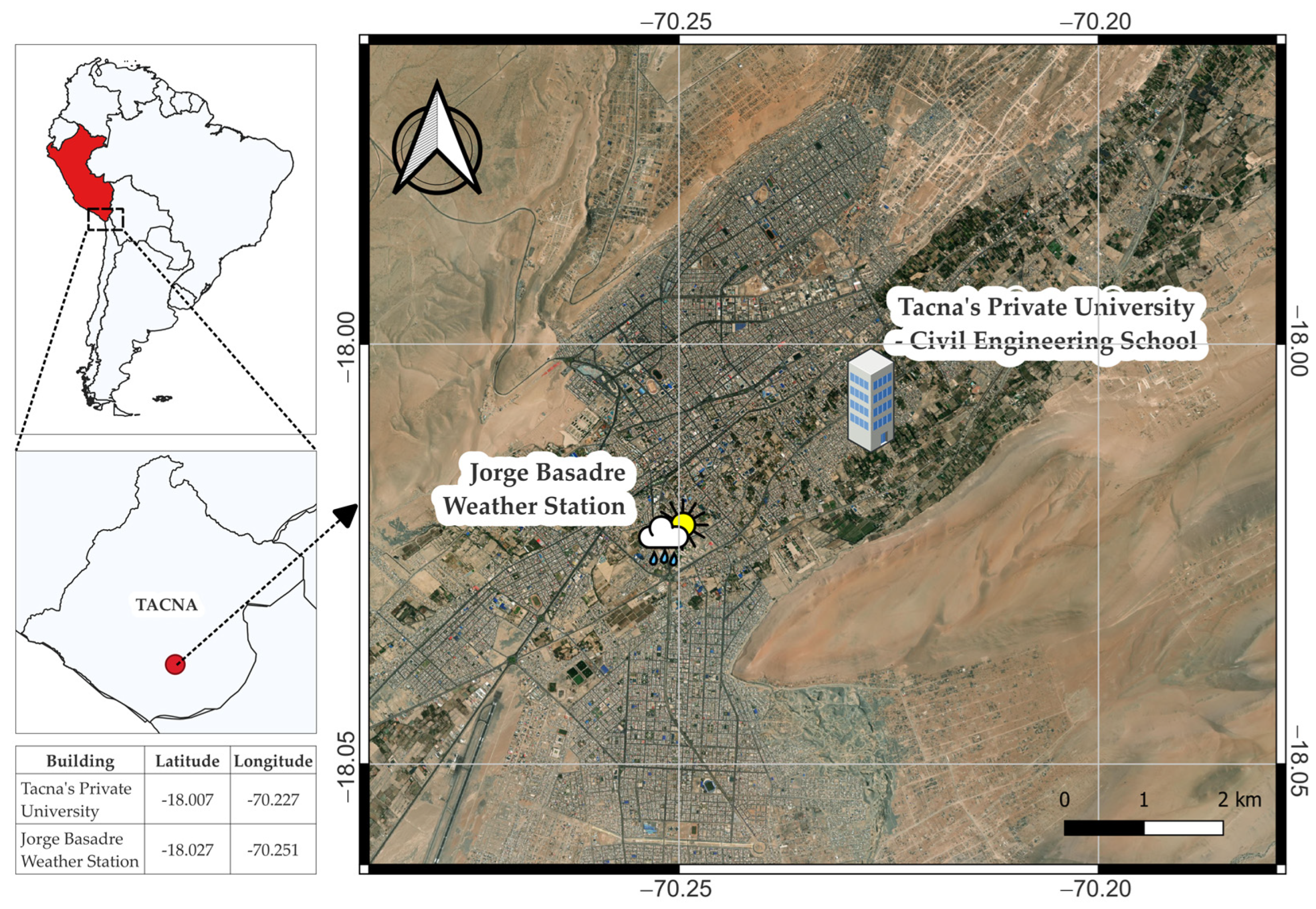
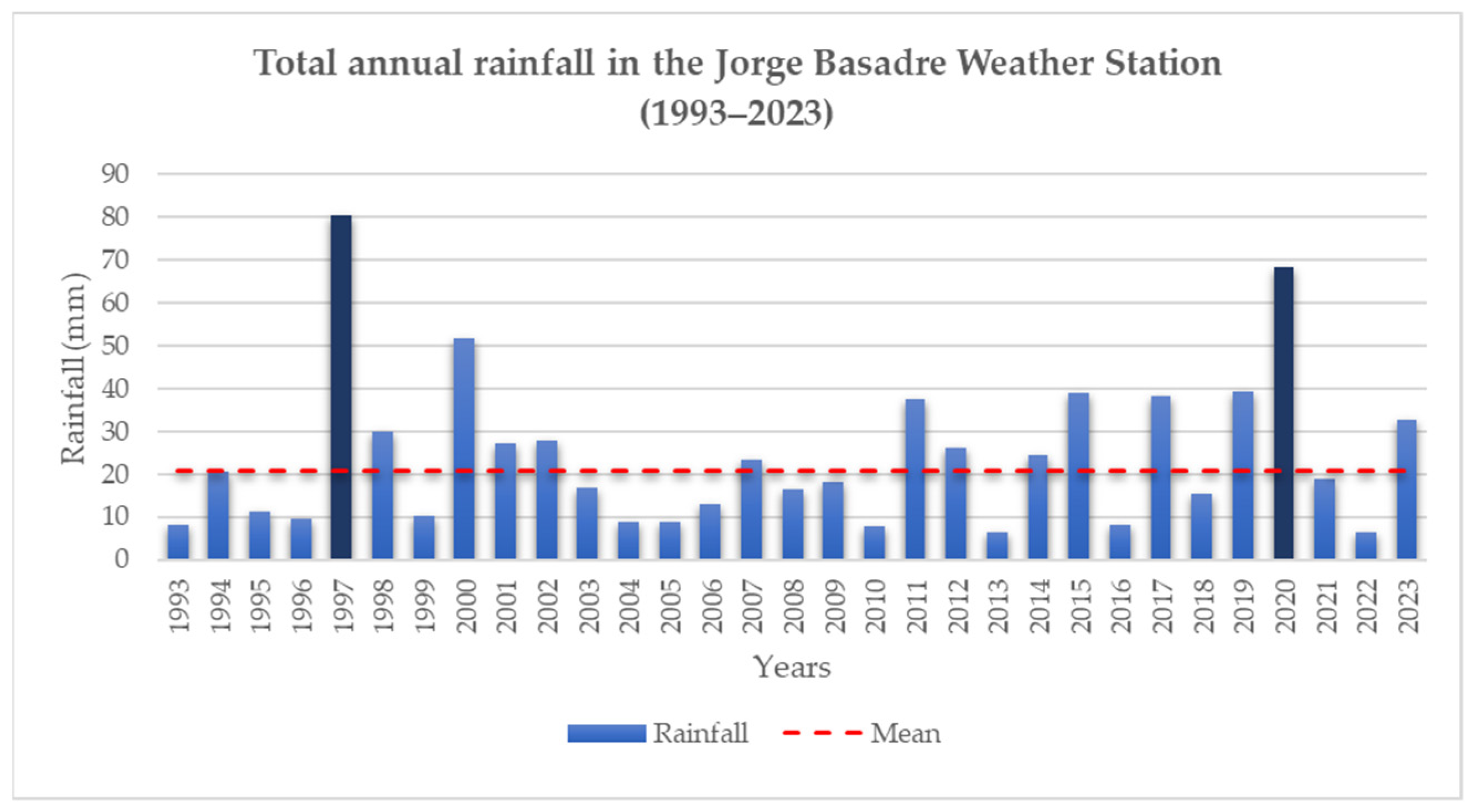
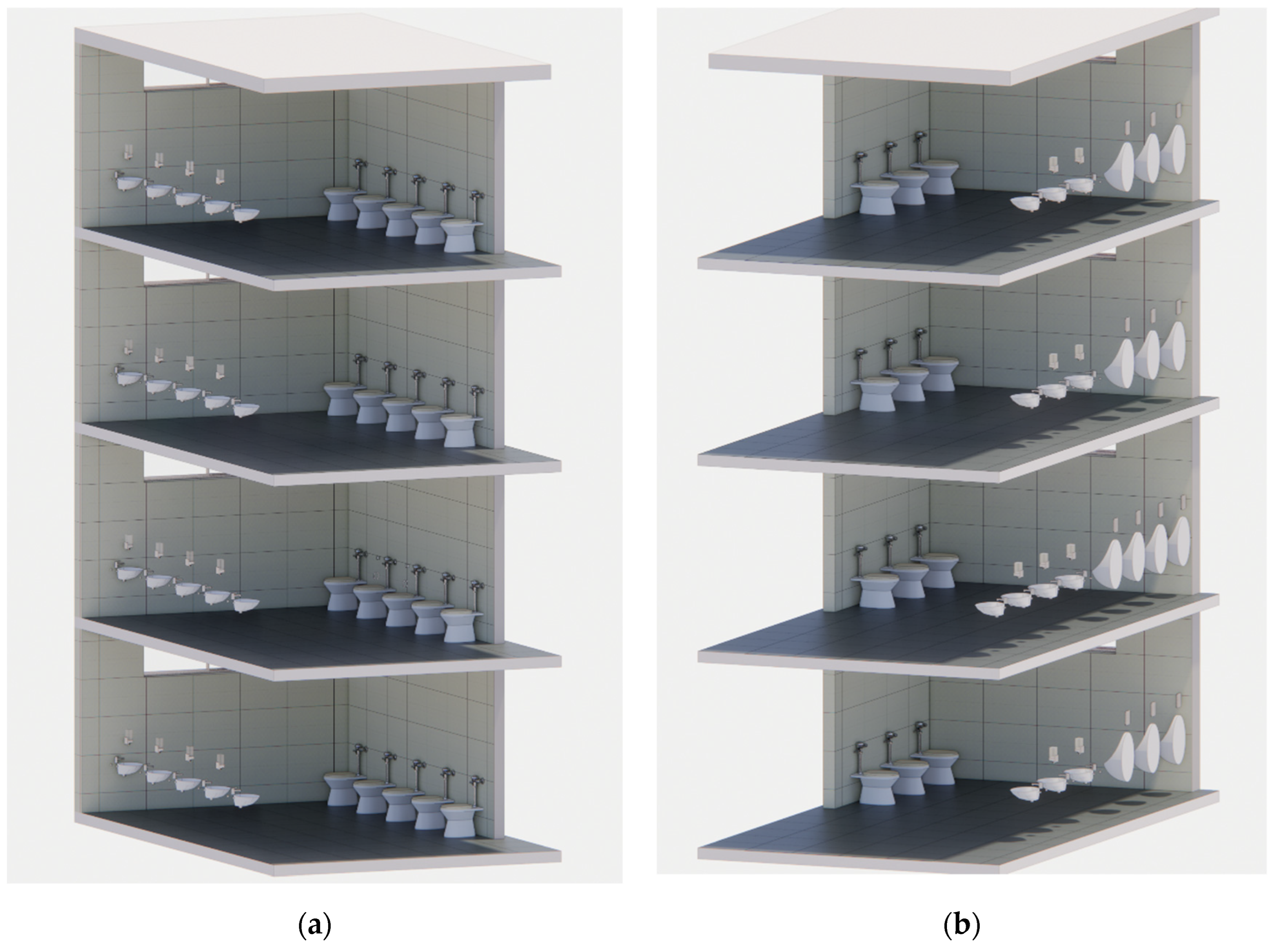
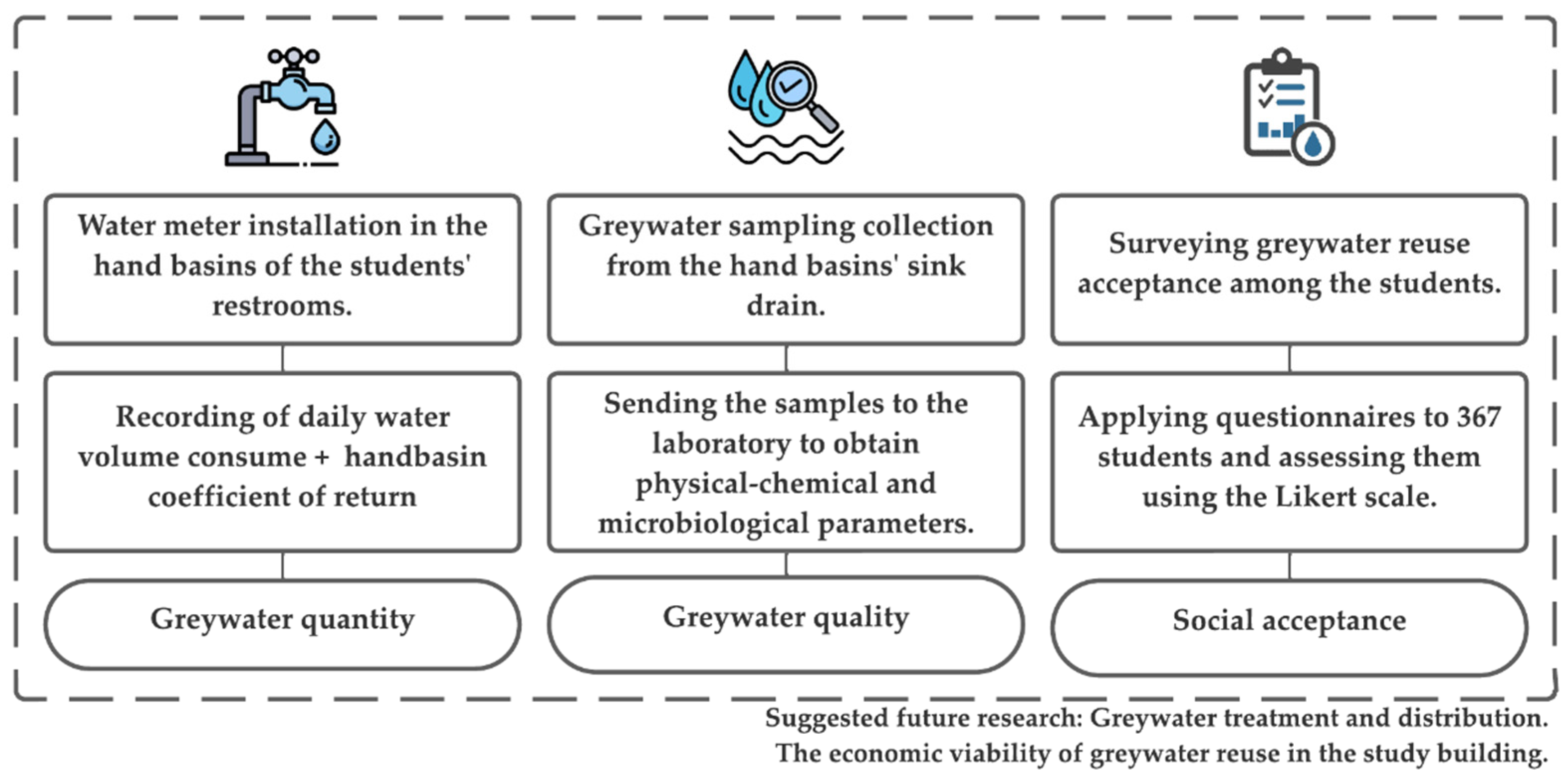
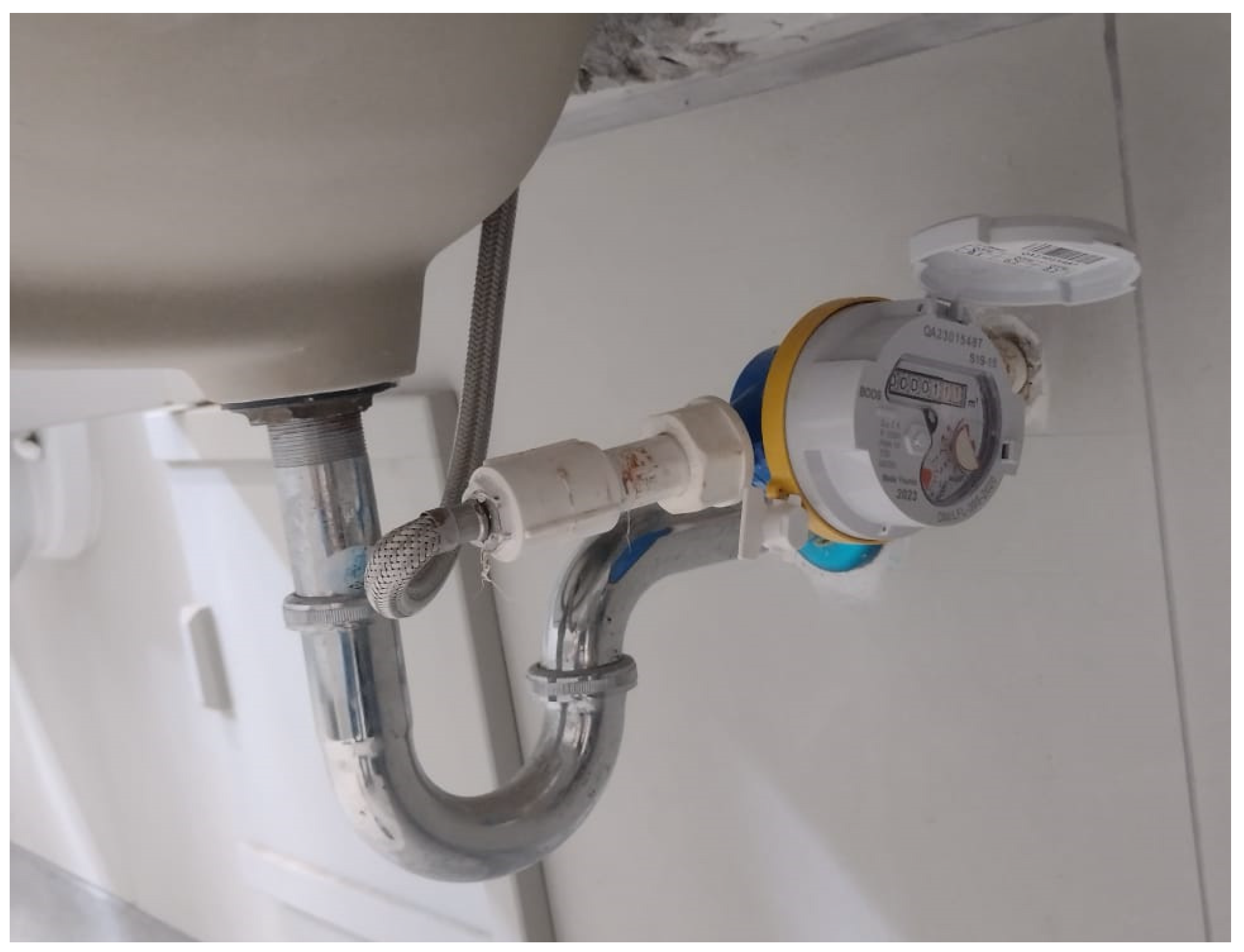
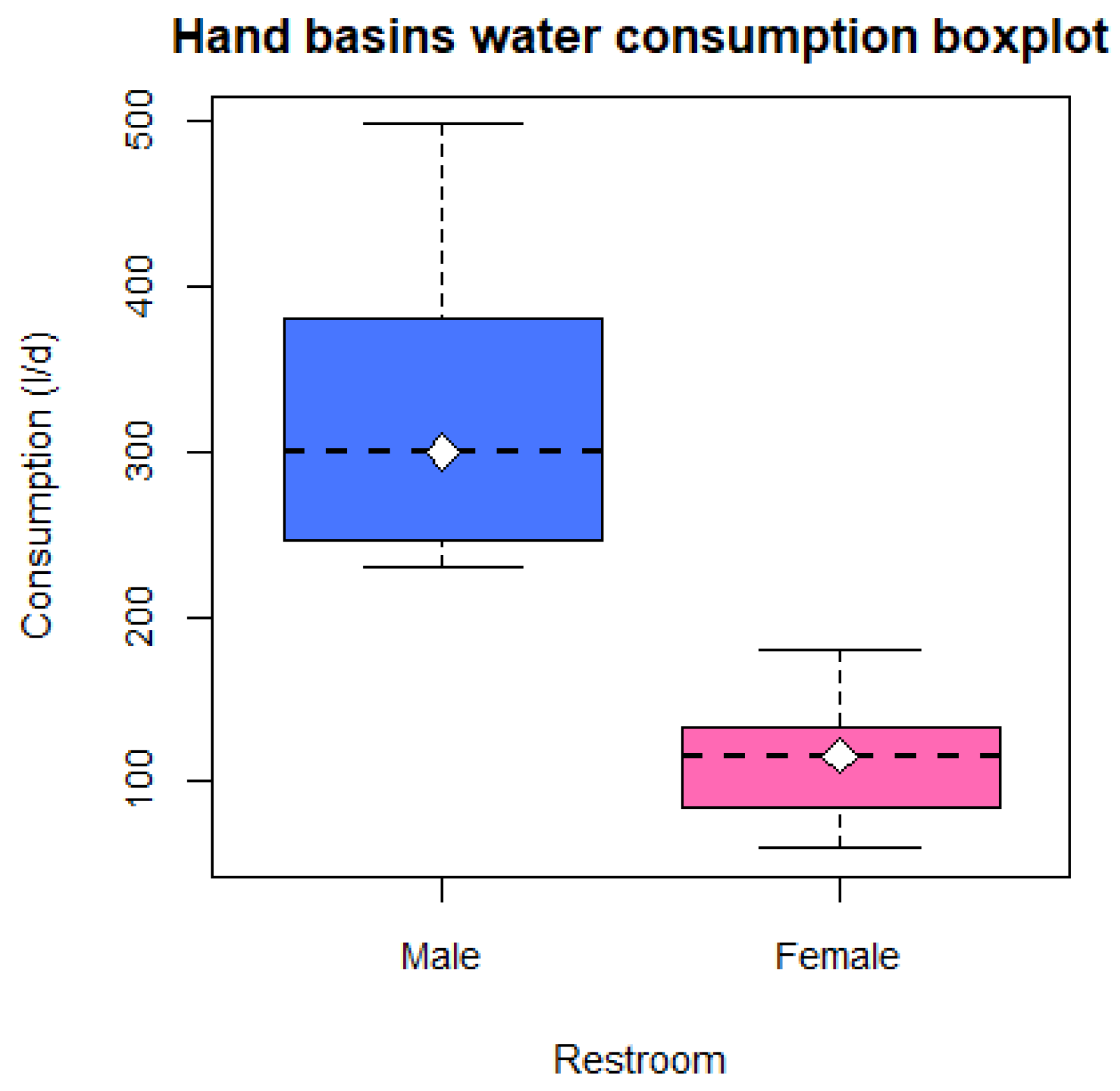
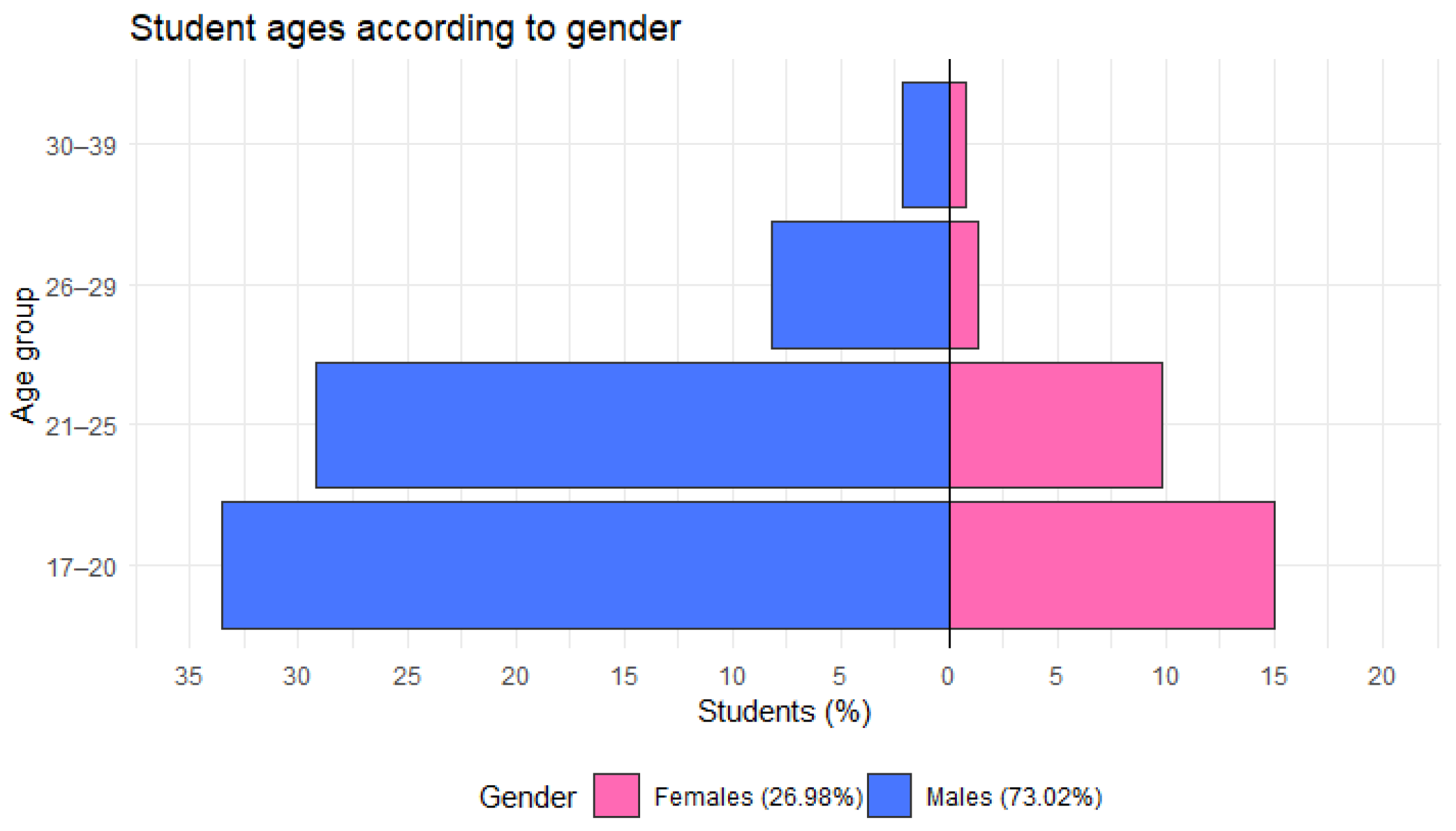
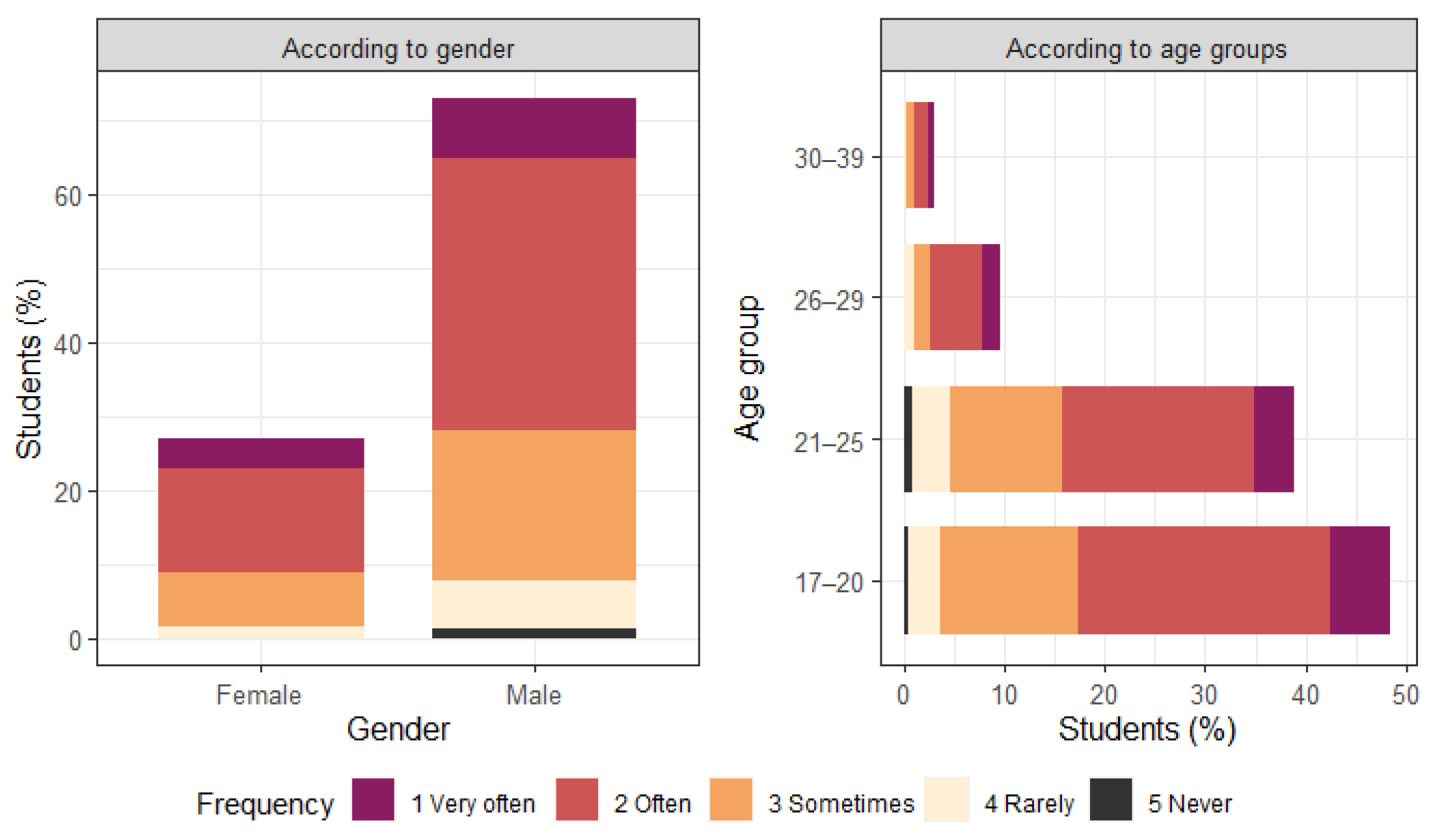

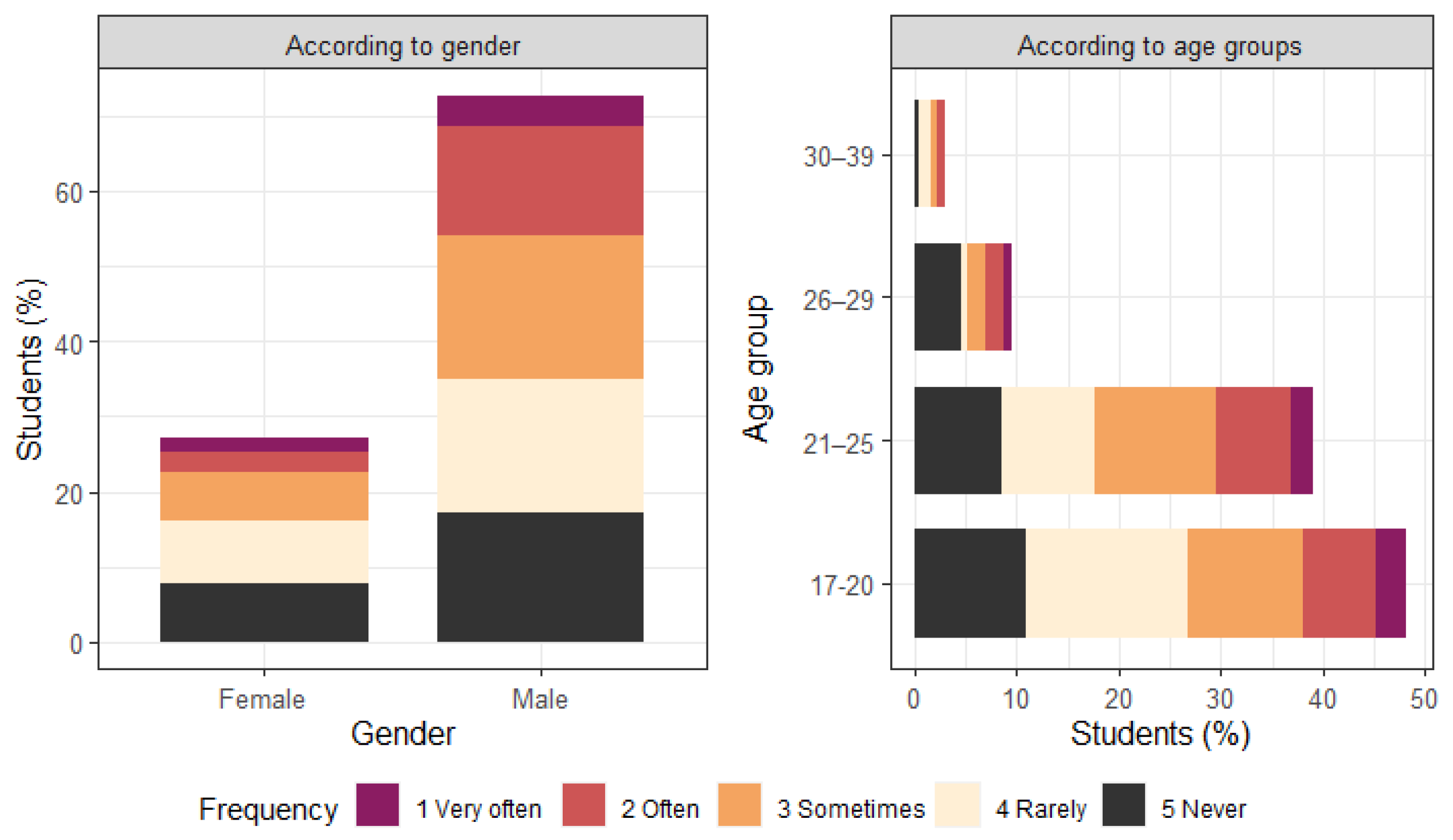
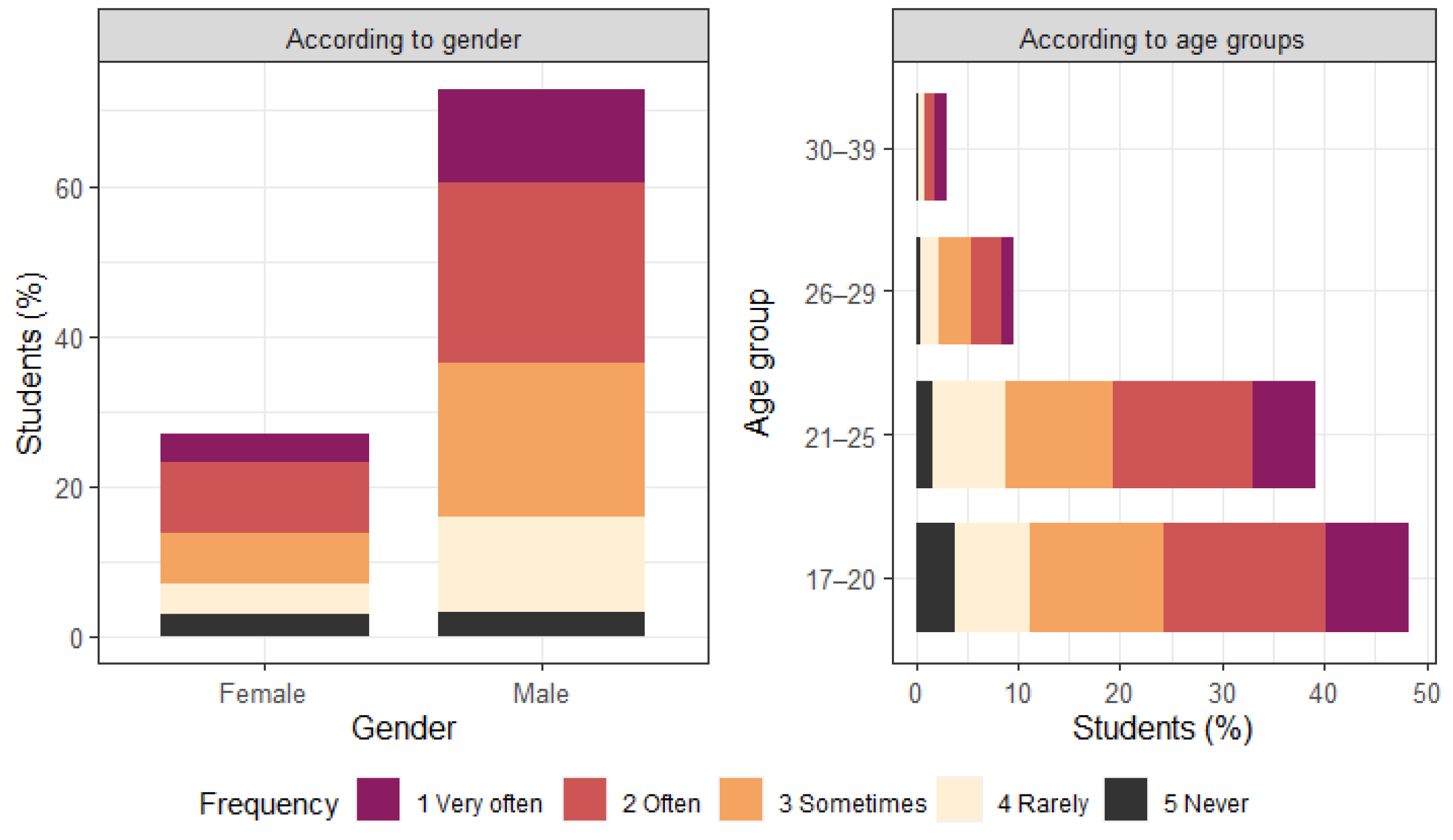
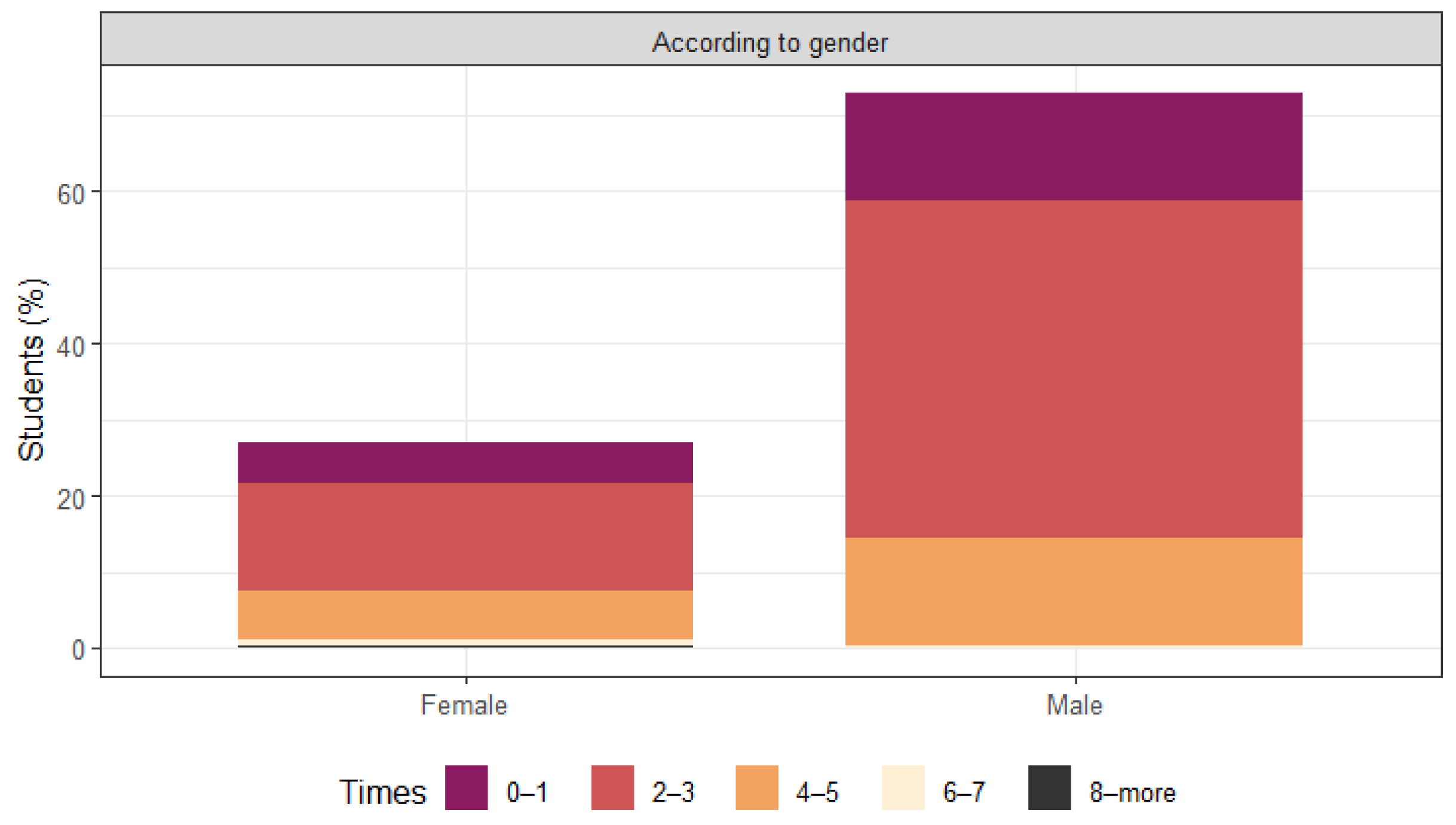
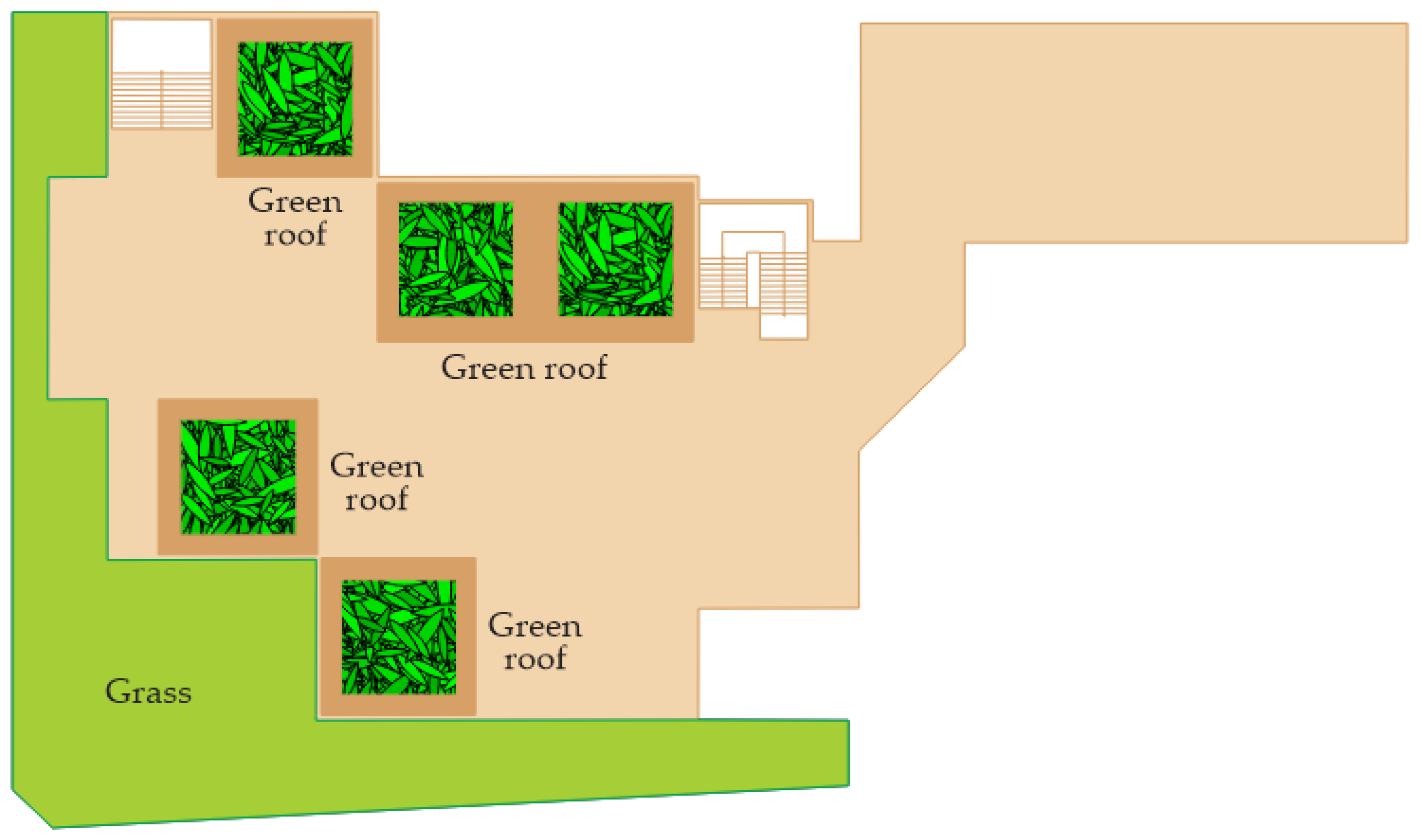
| Sanitary Fixture | Number | Water Consumption | Further Description |
|---|---|---|---|
| Tap/Faucet | 33 | 0.35 L/cycle | Self-closing, push-tap faucet |
| Urinal | 13 | 3.8 L/flush | Top siphon jet urinal |
| Toilet | 32 | 4.8 L/flush | Single flushing system |
| Parameter | Unit | Testing Methods |
|---|---|---|
| Oil and grease | mg/L | ASTM D3921-96 (Reapproved 2011) 2022. Standard Test Method for Oil and Grease and Petroleum Hydrocarbons in Water [54]. |
| Electrical conductivity (EC) | μS/cm | SMEWW-APHA-AWWA-WEF Part 2510 B, 24th Ed. 2023 Conductivity. Laboratory Method [55]. |
| Biochemical oxygen demand (BOD5) | mg/L | SMEWW-APHA-AWWA-WEF Part 5210 B, 24th Ed. 2023 Biochemical Oxygen Demand (BOD). 5-Day BOD test [55]. |
| Chemical oxygen demand (COD) | mg/L | SMEWW-APHA-AWWA-WEF Part 5220 D, 24th Ed. 2023 Chemical Oxygen Demand, Closed Reflux, Colorimetric Method [55]. |
| Phosphate (as phosphorus) | mg/L | EPA 300.0, Rev. 2.1. 1993. Determination of Inorganic Anions by Ion Chromatography [56]. |
| Nitrate (as N) | mg/L | EPA 300.0, Rev. 2.1. 1993. Determination of Inorganic Anions by Ion Chromatography [56]. |
| Nitrite (as N) | mg/L | EPA 300.0, Rev. 2.1. 1993. Determination of Inorganic Anions by Ion Chromatography [56]. |
| Dissolved oxygen (DO) | mg/L | SMEWW-APHA-AWWA-WEF Part 4500-O-C; 24th Ed: 2023. Oxygen (Dissolved): Azide Modification [55]. |
| Total suspended solids (TSS) | mg/L | SMEWW-APHA-AWWA-WEF Part 2540 D, 24th Ed. 2023 Solids. Total Suspended Solids. Dried from 103 to 105 °C [55]. |
| Turbidity | NTU | SMEWW-APHA-AWWA-WEF Part 2130 B, 24th Ed. 2023 Turbidity. Nephelometric Method [55]. |
| pH | SMEWW-APHA-AWWA-WEF Part 4500-H + B, 24th Ed. 2023 pH. Electromedic Method [55]. | |
| Total Kjeldahl nitrogen | mg/L | SMEWW-APHA-AWWA-WEF Part 4500-Norg-B, 23rd Ed: 2017. Nitrogen (organic). Macro-Kjeldahl Method [55]. |
| Total metals | mg/L | EPA-Method 200.8 Rev. 5.4, 1994 (Validated–Modified). 2016. Determination of trace elements in water and wastes by Inductively Coupled Plasma-Mass spectrometry [57]. |
| Heterotrophic plate count | CFU/mL | SMEWW-APHA-AWWA-WEF Part 9215 A, B, 24th Ed. 2023 Heterotrophic Plate Count. Pour Plate Procedure [55]. |
| Total coliforms | MNP/100 mL | SMEWW-APHA-AWWA-WEF Part 9221 B, 24th Ed. 2023 Multiple-Tube Fermentation Technique for Members of the Coliform Group. Standard Total Coliform Fermentation Technique. [55]. |
| Fecal coliforms or thermotolerant coliforms | MNP/100 mL | SMEWW-APHA-AWWA-WEF Part 9221 E.1, 24th Ed. 2023 Multiple-TubeFermentation Technique for Members of the Coliform Group. Thermotolerant (Fecal) Coliform Procedure. Thermotolerant Coliform Test (EC Medium) [55]. |
| Gender | Average Consumption (L/d) | Coefficient of Return | Greywater Quantity (L/d) |
|---|---|---|---|
| Male | 326.63 | 0.97 | 316.83 |
| Female | 113.43 | 0.97 | 110.03 |
| Total | 426.85 | ||
| Country | Study Building | Source | Occupants | Mean Generated Greywater (L/d) | Methodology |
|---|---|---|---|---|---|
| Brazil [39] | University building | Water taps with aerators | 445 | 427.05 | Literature review and equations |
| India [61] | Primary school | Hand wash and kitchen wash sinks | 197 | 667 | Not stated |
| Chile [40] | Secondary school | Washbasins | 1363 | 24,261 | Surveys regarding water usage |
| Kuwait [37] | Secondary school | Manually open handwash | 397 | 1151.3 | Flow meters were installed on the wash sink drains |
| This study | University building | Self-closing hand basins | 732 | 426.85 | Water meters were installed in the flexible supply tube |
| Parameter | Unit | Samples | Average | ||
|---|---|---|---|---|---|
| Sample 1 | Sample 2 | Sample 3 | |||
| Physical and chemical analysis | |||||
| pH | 6.64 ± 0.15 | 6.65 ± 0.15 | 6.73 ± 0.15 | 6.67 | |
| Turbidity | NTU | 12.2 ± 1.0 | 15.4 ± 1.20 | 12.6 ± 1.0 | 13.40 |
| Electrical conductivity (EC) | μS/cm | 817.00 ± 220.59 | 818.00 ± 220.86 | 820.00 ± 221.40 | 818.33 |
| Total suspended solids (TSS) | mg/L | 13 ± 4 | 17 ± 5 | 21 ± 6 | 17.00 |
| Total Kjeldahl nitrogen | mg/L | 5 | 5 | 6 | 5.33 |
| Dissolved oxygen (DO) | mg/L | 5.7 ± 1.50 | 7.5 ± 2.0 | 7.0 ± 1.80 | 6.73 |
| Chemical oxygen demand (COD) | mg/L | 95.0 ± 3.40 | 97.9 ± 3.40 | 98.8 ± 3.50 | 97.23 |
| Biochemical oxygen demand (BOD5) | mg/L | 33.9 ± 2.60 | 37.4 ± 2.60 | 39.7 ± 2.60 | 37.00 |
| Oil and grease | mg/L | 9.5 ± 0.40 | 7.4 ± 0.30 | 13.2 ± 0.40 | 10.03 |
| Anions | |||||
| Phosphate (as phosphorus) | mg/L | <0.033 | <0.033 | <0.033 | <0.033 |
| Nitrate (as nitrogen) | mg/L | <0.014 | <0.014 | <0.014 | <0.014 |
| Nitrite (as nitrogen) | mg/L | 0.126 ± 0.0060 | 0.038 ± 0.0020 | 0.045 ± 0.0020 | 0.07 |
| Cations | |||||
| Total aluminum | mg/L | <0.003 | <0.003 | <0.003 | <0.003 |
| Total calcium | mg/L | <0.009 | <0.009 | <0.009 | <0.009 |
| Total magnesium | mg/L | <0.003 | <0.003 | <0.003 | <0.003 |
| Microbiological analysis | |||||
| Heterotrophic plate count | CFU/mL | 28,000 ± 7840 | 370,000 ± 103,600 | 32,000 ± 8960 | 143,000 |
| Total coliforms | MPN/100 mL | 11,000 | 540,000 | 92,000 | 214,000 |
| Fecal coliforms or thermotolerant coliforms | MPN/100 mL | 4900 | 110,000 | 11,000 | 41,900 |
| Location | Tacna, Perú | Kuwait [37] | Japan [42] | India [61] | Kumasi, Ghana [63] | Lima, Perú [64,65] | Ado-Ekiti, Nigeria [61] | |
| Study Building | University building (this study) | Schools | University research building | Schools in rural areas | Residential neighborhood (university campus) | University campus (faculty) | University campus | |
| Source | Hand basins | Hand basins | Mixed | Handwash | Bathrooms, kitchen, laundry, and sink | Hand basins | Mixed | |
| Parameters | Units | |||||||
| pH | 6.64–6.73 | 5.95–8.69 | 5.9 ± 0.58 | 6.1–6.73 | 7.6 | 7.3–10.94 | ||
| Turbidity | NTU | 12.2–15.4 | 0.07–36.4 | 196 ± 112 | 270 | 61.5 | 88.7–854 | |
| Electrical conductivity (EC) | μS/cm | 817–820 | 177–1446 | 394 ± 133 | 280–616.2 | 975 | 12.46–25.4 | |
| Total suspended solids (TSS) | mg/L | 13–21 | 2–146 | 74 ± 37 | 351 ± 223 | 180–190 | 1 | |
| Total dissolved solids (TDS) | mg/L | 90–300 | 172–382 | 9.63–1424 | ||||
| Total solids (mg/L) | mg/L | 110–466 | ||||||
| Total Kjeldahl nitrogen | mg/L | 5–6 | 13 ± 5.3 | |||||
| Dissolved oxygen (DO) | mg/L | 5.7–7.5 | 5.8–7.8 | 0.1–6.69 | 4.22–5.88 | |||
| Chemical oxygen demand (COD) | mg/L | 95–98.8 | 6.4–170 | 643 ± 387 b | 690–740 | 163 | 96–164 | |
| Biochemical oxygen demand (BOD5) | mg/L | 33.9–39.7 | 0–65 | 227 ± 128 | 320–350 | 22–48 | ||
| Biological oxygen demand (BOD) | mg/L | 344 ± 272 b | 8 | |||||
| Total organic carbon (TOC) | mg/L | 100 ± 57 | ||||||
| Oil and grease | mg/L | 7.4–13.2 | ||||||
| Phosphate (as phosphorus) | mg/L | <0.033 | <0.05–2.6 | 0.37 ± 0.42 | 1.03 ± 0.68 | 1.3–6 | ||
| Nitrate (as N) | mg/L | <0.014 | <0.03–31.1 | 0.10 ± 0.13 | 34 ± 6 b | 0.5–12.9 | ||
| Nitrite (as N) | mg/L | 0.038–0.126 | <0.02–2.6 | 0.00–0.06 | ||||
| Heterotrophic plate count | CFU/mL | 28,000–370,000 | ||||||
| Total coliforms | MPN/100 mL | 11,000–540,000 | 89–352 | 1.4 × 106 ± 3.5 × 106 | ||||
| Fecal or thermotolerant coliforms | MPN/100 mL | 4900–110,000 | 0 | 2.35 × 108 a |
| Country/ Organization | Parameters | ||||||||||||
|---|---|---|---|---|---|---|---|---|---|---|---|---|---|
| pH | Turbidity (mg/L) | TSS (mg/L) | BOD5 (mg/L) | COD (mg/mL) | DO | Total Nitrogen (mg/L) | Nitrate (NO3) | Total Chlorine Residual (mg/L) | Fecal or Thermotolerant Coliforms (CFU/100 mL) | Total Coliforms (CFU/100 mL) | E. coli (CFU/100 mL) | Applications | |
| USA [53] | 6–9 | ≤2 (avg) | ≤10 | ≥1 | undetectable | <2.2 (avg) | <100 | Unrestricted urban reuse/toilet flushing | |||||
| <5 (max) | <23 (max) | ||||||||||||
| USA [53] | 6–9 | 2 | 10 | 10 | 2.2 b | Multi-family and commercial (restricted indoor and unrestricted outdoor use) | |||||||
| WHO [52] | ≤10 | ≤10 | ≤10 | Toilet flushing | |||||||||
| ≤140 | ≤240 | ≤1000 | Irrigation of ornamentals, fruit trees, and fodder crops | ||||||||||
| Jordanian [51] | 6–9 | 10 a | 50 | 30 | 100 | >2.0 | 45 | 30 | 100 b | Cooked vegetables, parking areas, and playgrounds | |||
| 6–9 | 150 | 200 | 500 | 70 | 45 | 1000 | Agricultural irrigation tree crops and green areas | ||||||
| Restroom Usage at the University (Times/Day) | Male | Female | |||
|---|---|---|---|---|---|
| Questionaries | Average (1) | % (2) | Weighted Times (3) = (1) × (2) | % (4) | Weighted Times (5) = (1) × (4) |
| 0−1 | 0.5 | 14.17 | 7.08 | 5.45 | 2.72 |
| 2−3 | 2.5 | 44.41 | 111.04 | 14.17 | 35.42 |
| 4−5 | 4.5 | 14.17 | 63.76 | 6.27 | 28.20 |
| 6−7 | 6.5 | 0.27 | 1.77 | 0.82 | 5.31 |
| 8−more | 8.5 | 0.00 | 0.00 | 0.27 | 2.32 |
| Total | 73.02 | 183.65 | 26.98 | 73.98 | |
| Weighted times (times/day) | 2.51 | 2.74 | |||
| Restroom | Students | Usage (Times/Day) | Sanitary Fixture | Water Demand for Toilet/Urinal Flushing (L/d) | |
|---|---|---|---|---|---|
| Type | Water Consumption (L/Flush) | ||||
| Male | 234 | 2.51 | 316.83 | 3.8 | 2236.27 |
| Female | 86 | 2.74 | 110.03 | 4.8 | 1132.07 |
| Total water demand for toilet/urinal flushing (l/d) | 3368.34 | ||||
| Activity | Area (m2) | Water Consumption (L/m2/d) | Water Demand |
|---|---|---|---|
| Green roof watering | 125.00 | 2.7 | 337.50 |
| Garden watering | 359.83 | 2.0 | 719.66 |
| Water Demand | Greywater Offer | Water Saving per Activity (%) | ||
|---|---|---|---|---|
| Activity | Volume (L/d) | Activity | Volume (L/d) | |
| Toilet flushing | 3368.34 | Greywater from hand basins | 426.85 | 12.67 |
| Green roof watering | 337.50 | 853.70 1 | 100.00 | |
| Garden watering | 719.66 | 853.70 1 | 100.00 | |
Disclaimer/Publisher’s Note: The statements, opinions and data contained in all publications are solely those of the individual author(s) and contributor(s) and not of MDPI and/or the editor(s). MDPI and/or the editor(s) disclaim responsibility for any injury to people or property resulting from any ideas, methods, instructions or products referred to in the content. |
© 2024 by the authors. Licensee MDPI, Basel, Switzerland. This article is an open access article distributed under the terms and conditions of the Creative Commons Attribution (CC BY) license (https://creativecommons.org/licenses/by/4.0/).
Share and Cite
Lanchipa-Ale, T.; Cruz-Baltuano, A.; Molero-Yañez, N.; Chucuya, S.; Vera-Barrios, B.; Pino-Vargas, E. Assessment of Greywater Reuse in a University Building in a Hyper-Arid Region: Quantity, Quality, and Social Acceptance. Sustainability 2024, 16, 3088. https://doi.org/10.3390/su16073088
Lanchipa-Ale T, Cruz-Baltuano A, Molero-Yañez N, Chucuya S, Vera-Barrios B, Pino-Vargas E. Assessment of Greywater Reuse in a University Building in a Hyper-Arid Region: Quantity, Quality, and Social Acceptance. Sustainability. 2024; 16(7):3088. https://doi.org/10.3390/su16073088
Chicago/Turabian StyleLanchipa-Ale, Teresa, Ana Cruz-Baltuano, Nahuel Molero-Yañez, Samuel Chucuya, Bertha Vera-Barrios, and Edwin Pino-Vargas. 2024. "Assessment of Greywater Reuse in a University Building in a Hyper-Arid Region: Quantity, Quality, and Social Acceptance" Sustainability 16, no. 7: 3088. https://doi.org/10.3390/su16073088
APA StyleLanchipa-Ale, T., Cruz-Baltuano, A., Molero-Yañez, N., Chucuya, S., Vera-Barrios, B., & Pino-Vargas, E. (2024). Assessment of Greywater Reuse in a University Building in a Hyper-Arid Region: Quantity, Quality, and Social Acceptance. Sustainability, 16(7), 3088. https://doi.org/10.3390/su16073088








